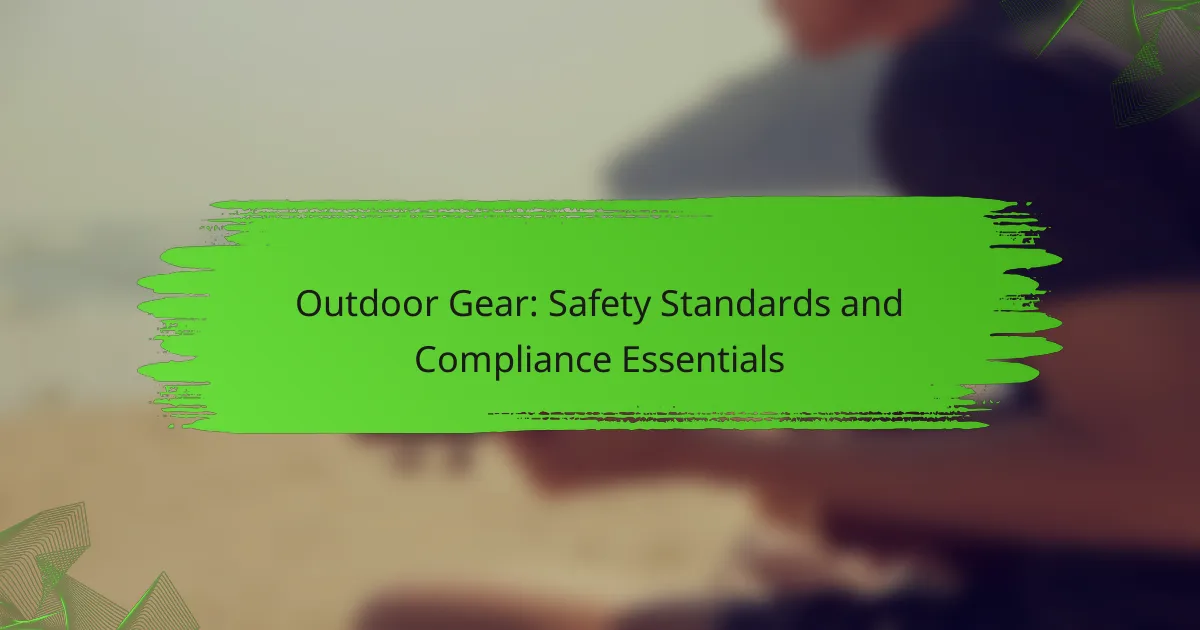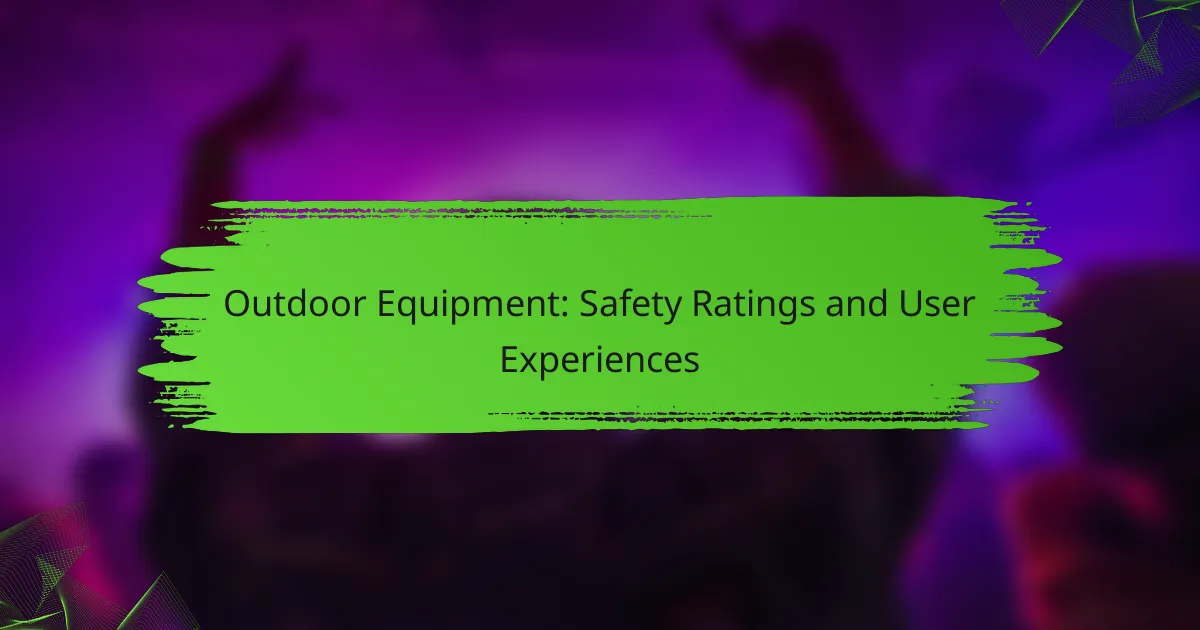Outdoor navigation tools are essential for ensuring safety during adventures in challenging terrains. By providing reliable GPS tracking, route planning, and emergency features, these tools help users navigate effectively while minimizing the risk of getting lost. When choosing the right navigation device or application, it’s important to consider factors such as battery life, water resistance, and usability to enhance your outdoor experience.

What are the best outdoor navigation tools for safety?
The best outdoor navigation tools for safety include devices and applications that provide reliable GPS tracking, route planning, and emergency features. These tools help users navigate challenging terrains while ensuring they can find their way back or call for help if needed.
Garmin GPSMAP 66i
The Garmin GPSMAP 66i is a robust handheld GPS device that combines navigation and communication features. It offers topographic maps, satellite imagery, and inReach technology for two-way messaging and SOS alerts, making it ideal for remote areas.
When using the GPSMAP 66i, ensure that you download the necessary maps before heading out, as cellular coverage may be limited. Regularly check battery levels and carry a power bank for extended trips.
Suunto Traverse Alpha
The Suunto Traverse Alpha is a versatile GPS watch designed for outdoor enthusiasts. It features GPS tracking, a barometric altimeter, and a compass, allowing users to monitor their location and altitude accurately.
This watch is particularly useful for hiking and hunting, as it includes a breadcrumb trail feature to help retrace steps. Remember to familiarize yourself with its functions before your trip to maximize its potential.
Apple Maps
Apple Maps is a user-friendly navigation app available on iOS devices, providing turn-by-turn directions and real-time traffic updates. While it is primarily designed for urban navigation, it can be useful for outdoor activities in areas with good cellular coverage.
To enhance safety, download offline maps before your journey, as this will allow you to navigate without relying on a data connection. Be cautious, as Apple Maps may not always provide the most accurate trails for remote hiking paths.
AllTrails Pro
AllTrails Pro is a popular app among hikers, offering a vast database of trail maps and user-generated reviews. It allows users to download maps for offline use, track their progress, and share experiences with the community.
Utilize the app’s features to plan your route and check for trail conditions before heading out. Always carry a backup navigation method, as app functionality may be limited in remote areas.
Komoot
Komoot is an outdoor navigation app that specializes in route planning for hiking, biking, and other activities. It provides detailed topographic maps and allows users to customize routes based on their preferences and skill levels.
Before starting your adventure, plan your route and download the necessary maps for offline access. Komoot’s voice navigation feature can help keep your hands free while you focus on the trail ahead.
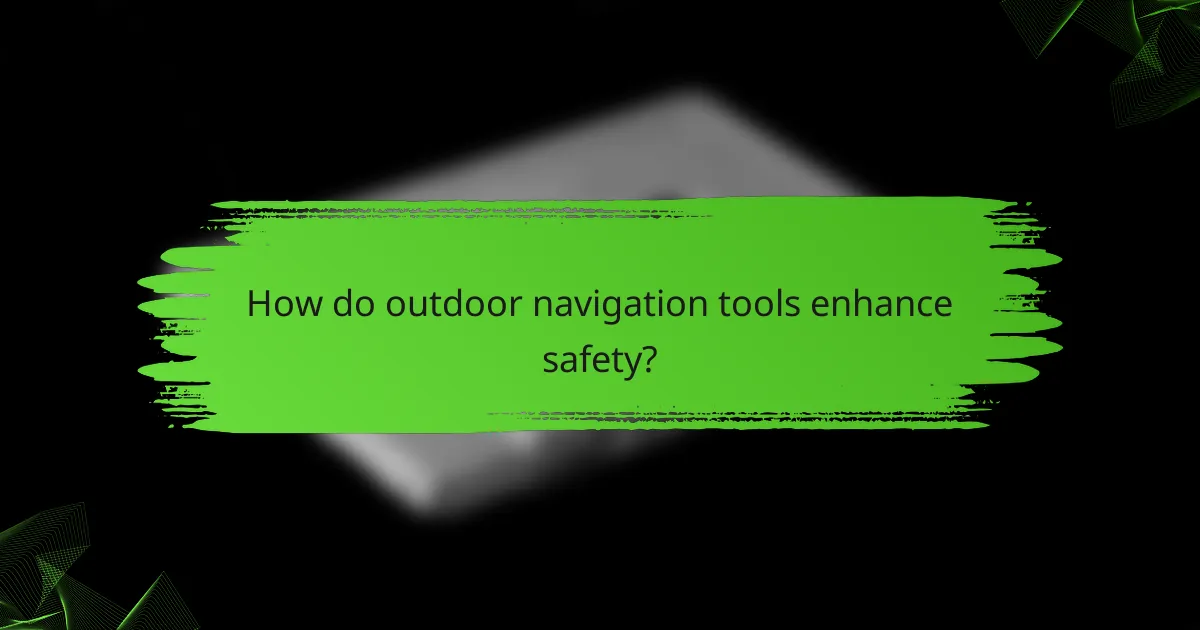
How do outdoor navigation tools enhance safety?
Outdoor navigation tools significantly enhance safety by providing users with accurate location information, emergency features, and detailed maps. These tools help prevent getting lost, facilitate quick rescue in emergencies, and allow for informed decision-making during outdoor activities.
Real-time location tracking
Real-time location tracking allows users to know their exact position at any moment, which is crucial for safety in unfamiliar terrain. Many GPS devices and smartphone apps provide this feature, updating location every few seconds to ensure accuracy.
When selecting a navigation tool, consider battery life and signal reliability, especially in remote areas. Tools that rely on cellular networks may not function well in regions with poor coverage, so opting for GPS-only devices can be more reliable.
Emergency SOS features
Emergency SOS features are designed to alert authorities or emergency contacts when a user is in distress. Many modern navigation tools include a dedicated SOS button that sends location coordinates to emergency services, significantly speeding up response times.
When using these features, ensure that your device is registered with local emergency services and that you understand how to activate the SOS function. Familiarize yourself with the specific protocols in your area, as they can vary by region.
Topographic mapping
Topographic mapping provides detailed information about the terrain, including elevation changes, water sources, and trails. This information is vital for planning safe routes and avoiding hazardous areas, particularly in mountainous or rugged regions.
When choosing a navigation tool, look for one that offers high-quality topographic maps. Some tools allow users to download maps for offline use, which is essential in areas without cellular service. Regularly update your maps to ensure they reflect any changes in the landscape.
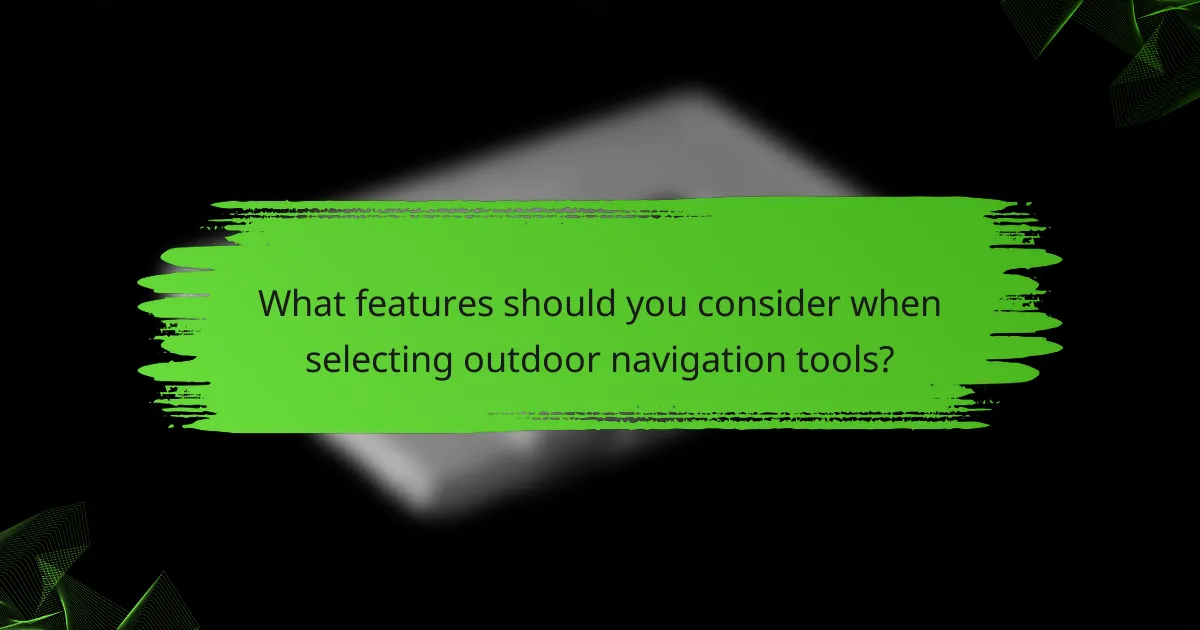
What features should you consider when selecting outdoor navigation tools?
When selecting outdoor navigation tools, consider features that enhance usability and reliability in various conditions. Key aspects include battery life, water resistance, screen visibility, and ease of use, all of which significantly impact your navigation experience in the outdoors.
Battery life
Battery life is crucial for outdoor navigation tools, especially during extended trips. Look for devices that offer a minimum of 10-20 hours of active use, as this will ensure they last through long hikes or camping trips without needing a recharge.
Consider tools with power-saving modes or the ability to use standard batteries, which can be replaced easily in the field. Always check user reviews for real-world battery performance, as advertised times may not reflect actual usage.
Water resistance
Water resistance is essential for outdoor navigation tools, as weather conditions can change rapidly. Look for devices with an IPX7 rating or higher, which can withstand immersion in water up to 1 meter for 30 minutes.
Additionally, consider the material and build quality of the device. A rugged design can provide extra protection against rain, splashes, and accidental drops, ensuring your navigation tool remains functional in adverse conditions.
Screen visibility
Screen visibility is vital for reading maps and directions in various lighting conditions. Opt for devices with high-contrast screens that are easily readable in bright sunlight and low light.
Touchscreen interfaces should be responsive and usable with gloves, as outdoor activities often require protective gear. Some models offer backlighting or adjustable brightness settings, which can enhance visibility during dawn or dusk.
Ease of use
Ease of use is a key factor in selecting outdoor navigation tools, as complex interfaces can lead to mistakes in critical situations. Choose devices with intuitive menus and clear icons that allow for quick access to essential functions.
Consider the learning curve associated with each tool. Some brands offer user-friendly tutorials or customer support, which can be beneficial for beginners. Always test the device before heading out to ensure you are comfortable with its operation.
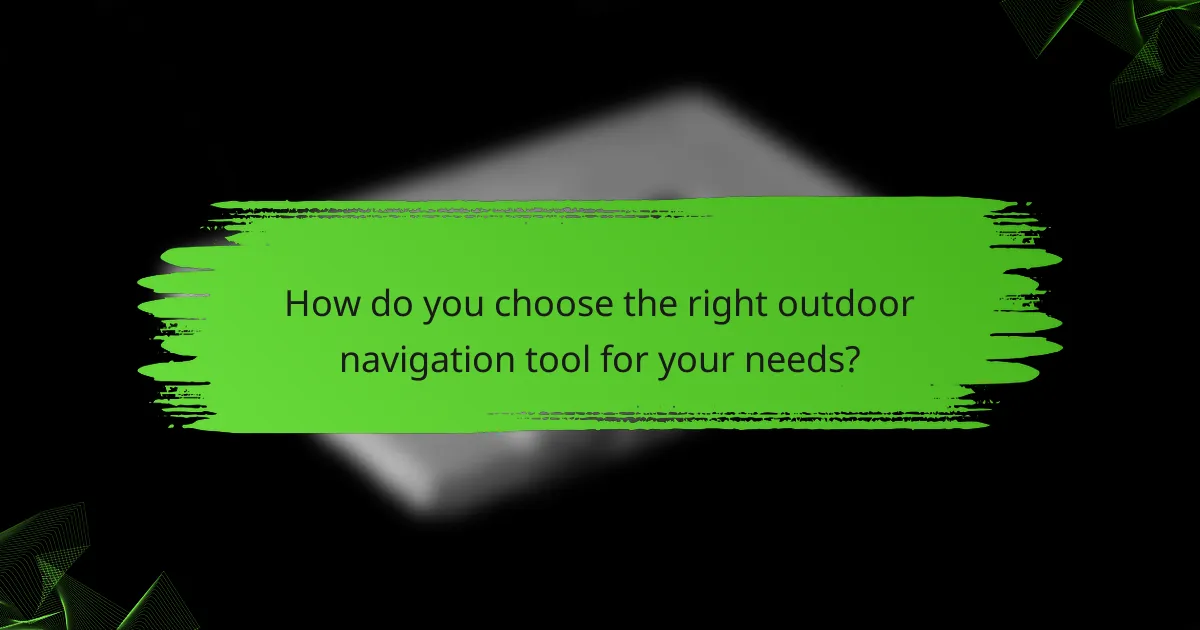
How do you choose the right outdoor navigation tool for your needs?
Choosing the right outdoor navigation tool involves understanding your specific activities, assessing user feedback, and comparing prices. Each tool has unique features tailored for different environments and user preferences, making it essential to evaluate these factors before making a decision.
Assessing your activity type
Your choice of navigation tool should align with the type of outdoor activity you plan to undertake. For instance, hikers may prefer handheld GPS devices with topographic maps, while cyclists might benefit from smartphone apps that track routes and elevation changes.
Consider the environment as well; tools designed for rugged terrains often include features like waterproofing and durable casing. If you’re engaging in activities like kayaking or mountaineering, look for navigation tools that offer real-time tracking and emergency features.
Evaluating user reviews
User reviews provide valuable insights into the performance and reliability of navigation tools. Look for feedback on ease of use, battery life, and accuracy, as these factors can significantly impact your outdoor experience.
Pay attention to reviews from users who engage in similar activities to yours, as their experiences can highlight strengths and weaknesses relevant to your needs. Websites and forums dedicated to outdoor gear often feature detailed user ratings and comparisons.
Comparing pricing options
Pricing for outdoor navigation tools can vary widely, from budget-friendly smartphone apps to high-end GPS devices costing several hundred dollars. Establish a budget based on your intended use and the features you need.
Consider the long-term value of the tool; sometimes, investing in a more expensive, durable option can save you money over time. Look for seasonal sales or bundle deals that may offer additional savings on navigation tools and accessories.

What are the common mistakes to avoid when using outdoor navigation tools?
Common mistakes when using outdoor navigation tools include neglecting updates, poor battery management, and over-reliance on technology. Avoiding these pitfalls can enhance safety and improve navigation accuracy during outdoor activities.
Neglecting regular updates
Failing to regularly update your navigation tools can lead to outdated maps and inaccurate information. Many navigation apps and devices release updates that include new trails, road changes, and safety alerts. Check for updates at least monthly or before significant trips to ensure you have the latest data.
Additionally, consider subscribing to alerts from your navigation service to stay informed about critical changes in your area. This practice is especially important in regions where trails and paths can change frequently due to weather or maintenance.
Ignoring battery management
Proper battery management is crucial for outdoor navigation tools, as a dead battery can leave you stranded. Always start with a fully charged device and carry a backup power source, such as a portable charger or extra batteries. Aim for a power bank with at least 10,000 mAh for longer trips.
Monitor your battery usage during your outing. Adjust settings like screen brightness and GPS frequency to conserve power. If your device has a battery-saving mode, activate it to extend usage time when needed.
Over-reliance on technology
While technology can greatly assist in navigation, over-reliance on devices can be risky. Always carry a physical map and compass as backups, especially in remote areas where signal loss is common. Familiarize yourself with basic navigation skills to ensure you can find your way without technology if necessary.
Consider using technology as a supplement rather than a sole resource. For instance, use your GPS for route planning but rely on traditional navigation methods during the actual hike. This balanced approach enhances your overall safety and confidence in outdoor navigation.

What are the emerging trends in outdoor navigation tools?
Emerging trends in outdoor navigation tools focus on enhanced accuracy, user-friendly interfaces, and integration with mobile technology. Innovations like augmented reality (AR) and real-time data sharing are reshaping how outdoor enthusiasts navigate and explore.
Increased use of mobile applications
Mobile applications for outdoor navigation are becoming increasingly popular due to their accessibility and functionality. These apps often provide features such as offline maps, route planning, and real-time tracking, making them ideal for hikers and adventurers. Users should consider battery life and data usage when selecting an app.
Integration of augmented reality
Augmented reality is transforming outdoor navigation by overlaying digital information onto the physical world. This technology allows users to visualize trails, landmarks, and points of interest directly through their device’s camera. While AR can enhance navigation, it requires a compatible device and may drain battery life quickly.
Focus on safety features
Safety features in navigation tools are gaining importance, with many devices now including emergency alerts and location sharing. These features can be crucial in remote areas where help may be far away. Users should prioritize tools that offer reliable communication options and ensure they understand how to use these safety features effectively.
Advancements in GPS technology
Recent advancements in GPS technology have improved accuracy and reliability, particularly in challenging environments like dense forests or mountainous regions. Modern devices often utilize multi-constellation systems, which can significantly enhance location precision. When selecting a GPS device, consider its ability to connect to various satellite systems for optimal performance.

